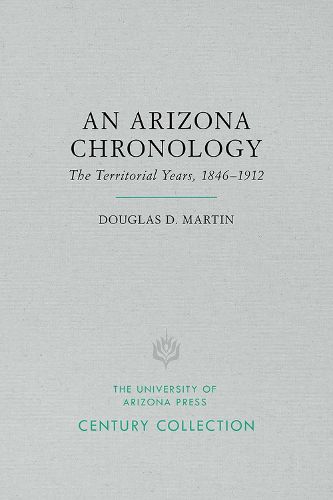Readings Newsletter
Become a Readings Member to make your shopping experience even easier.
Sign in or sign up for free!
You’re not far away from qualifying for FREE standard shipping within Australia
You’ve qualified for FREE standard shipping within Australia
The cart is loading…






The lively role of the newspaper in telling history’s story comes across in An Arizona Chronology, Volume Two, the continued selection by the late veteran journalist, Douglas D. Martin, of reported highlights in Arizona’s first two and a half decades as a state.
Here were the years in which Arizona’s bad men virtually dropped out of sight, and the trigger-blast was displaced by the gavel-thumping sound of law and order as a Territory grew up and became a state. The problem of the Apache was no more, and the problem of water began to loom large. Depression and prohibition were the counter-themes. And Arizona’s three C’s-Copper, Cattle, and Cotton-were about to strike for their place in the national limelight.
It was a time of conversion. The vital currents of frontier energy were turned into the channels of modern agriculture, finance, and urban growth. As this volume’s editor, Patricia Paylore, points out, the transformation reaffirms Douglas Martin’s view of Arizona history as the persistence of the pioneer spirit of the 19th century in terms of the strength and optimism of a young people determined to take its place in the Union.
$9.00 standard shipping within Australia
FREE standard shipping within Australia for orders over $100.00
Express & International shipping calculated at checkout
The lively role of the newspaper in telling history’s story comes across in An Arizona Chronology, Volume Two, the continued selection by the late veteran journalist, Douglas D. Martin, of reported highlights in Arizona’s first two and a half decades as a state.
Here were the years in which Arizona’s bad men virtually dropped out of sight, and the trigger-blast was displaced by the gavel-thumping sound of law and order as a Territory grew up and became a state. The problem of the Apache was no more, and the problem of water began to loom large. Depression and prohibition were the counter-themes. And Arizona’s three C’s-Copper, Cattle, and Cotton-were about to strike for their place in the national limelight.
It was a time of conversion. The vital currents of frontier energy were turned into the channels of modern agriculture, finance, and urban growth. As this volume’s editor, Patricia Paylore, points out, the transformation reaffirms Douglas Martin’s view of Arizona history as the persistence of the pioneer spirit of the 19th century in terms of the strength and optimism of a young people determined to take its place in the Union.